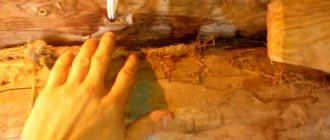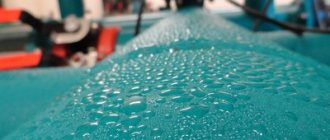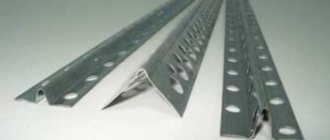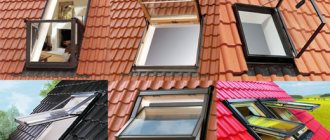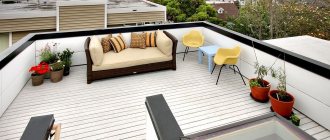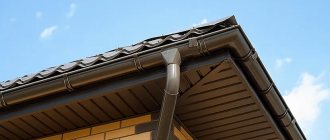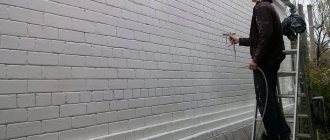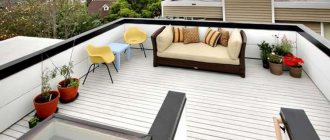The process of installing a roof is a very serious matter, which does not allow for savings on roofing materials and violations of their installation technology. Unfortunately, very often, due to the low qualifications of roofers, the homeowner, when putting his house into operation, is faced with serious problems, the elimination of which requires significant sums of money.
One of these troubles is condensation on the roof of a house, which not only leads to accelerated wear of the finishing coating and a decrease in the thermal insulation ability of the insulation, but also often makes the microclimate in the house unhealthy and unsuitable for living. In this article we will tell you why condensation occurs under the roof and how to deal with it.
Reasons for appearance
Roof condensation has a specific cause: moisture . Moisture appears when heated air in the house rises to the roof by natural current (its density is less than that of cold air). There, the indoor air encounters colder temperatures and cools quickly.
This leads to immediate condensation of the resulting droplets on all contacting surfaces, including the roof. It is not surprising that this process occurs more often during the colder months when home heating systems are turned on.
However, condensation is only part of the problem . The second part is that the excess moisture has nowhere else to go. Therefore, it can very quickly be absorbed into surrounding materials.
As a result, mold and fungi will begin to form, which will contribute to the gradual rotting of the wooden components of the rafter and sub-rafter structures. Insects will appear, which will add even more trouble to homeowners.
Condensation is predominantly associated with the attic areas of the house (and also with attics, if there are any), in fact, all elements of the roof structure become problematic . This may make it difficult to detect condensation problems.
Yes, wet streaks and drips remain telltale signs, but sometimes even thermographic imaging that monitors the intensity of infrared radiation is necessary to accurately resolve the problem. However, this type of monitoring is practically not used in everyday life.
In particularly cold regions of the country, condensation that forms on thin sheets of roofing (especially metal) often freezes. This leads to further damage to the roof, which is not easy to track initially.
Basic rules for roof installation
To prevent condensation from forming on the corrugated sheeting, it is important to adhere to the basic rules during roof installation.
Particular attention should be paid to laying thermal insulation. During operation, a large amount of this material is used.
Still, you should not save money by purchasing cheap material - the thermal insulation must be of high quality. Experts advise buying material whose thickness is at least 300 mm.
When laying thermal insulation, the following requirements must be met:
- do not use foam;
- lay the material on the rafter system;
- Do not lay thermal insulation material on the floor.
If this is not done, warm air will enter through the gaps and condensation will form.
Vapor and waterproofing must be of high quality. It will prevent water vapor contained in the air from contacting the surface of the roof, and will also eliminate drops of moisture if they do form.
Waterproofing material should be laid in horizontal rows. In this case, rows overlap.
During the formation of the under-roof space, it is important to properly organize ventilation. Air should circulate freely under the roof and between the battens.
As a result of good ventilation, there will be no condensation, and the under-roof space will not be damp, which will increase the service life of the roof and the entire structure.
Work should be carried out as follows:
- waterproofing is fixed on top of the rafters;
- then the counter-lattice is fixed;
- then the sheathing is laid on it. The laying step is most often 350 mm.
If you do not follow the procedure for forming the under-roof space, the air circulation will be disrupted, which will lead to the formation of condensation. Ventilation gaps must be at least 40 mm.
When hemming the cornice, it is important to use a perforated soffit. It is mounted on eaves overhangs.
Don't forget about the ventilated seal in the ridge. All this will allow air to freely penetrate through the cornice and then exit through the ridge itself.
It is necessary to install a roof aerator if the roof has a ventilation shaft larger than 1200 mm. He must be in front of and after the obstacle.
If the cause of condensation is poor ventilation, then after proper organization of the under-roof space, the dampness will disappear.
At any stage of roofing installation, it is necessary to correctly assemble the roofing elements.
It is recommended to entrust this process to experienced specialists who know how to install roofs, taking into account the climatic characteristics of a particular area.
Where does it appear?
Based on the practice of operating private houses, condensation is most often observed:
- In the attic after it has been insulated, and the presence of condensation after (this is important!) the installed attic will aggravate the problem.
The benefits of attic insulation are well known (the opportunity to save on energy bills, increase the energy efficiency of the home, etc.). However, attic insulation has a significant drawback: it limits the home’s ability to “breathe.” Indoor spaces may be warm and cozy, but if the air does not circulate properly, it will not be able to get rid of the excess moisture it contains. - In new buildings: oddly enough, one of the reasons for condensation is not completely dry plaster.
When plastering walls, building materials have a certain moisture content, releasing its excess into the surrounding space. It is a mistake to believe that you can decide to move to a new home based on the appearance of the plaster. The humidity in a new room naturally decreases very slowly. And during this period, air saturated with moisture collides with the colder surface of the roof, causing condensation to appear. Therefore, in the first few months, ventilation should work more intensively.
For non-insulated attic hatches.
Poorly insulated (or poorly fitted) attic hatches allow flows of moist air to pass through. If the attic can't breathe, this air will gradually build up. Upon contact with cold slate or existing membrane, warm air will condense and moisture will flow down the inside of the roof.Result: the formation of puddles in the “dead” zones of the roof, and then in the attic.
- When the roof design is poor, complicating natural ventilation.
First of all, there is a lack of ventilation holes. It is known that for pitched roofs such holes are located horizontally, above the roof. In this case, the ceiling level that forms the cooled roof can be higher or lower than the rafters, as well as between them. But in any case, gaps form between the coating elements, which always need to be ventilated. A completely enclosed space in a warm pitched roof may not require ventilation.
Options for solving the problem
The garage can be insulated
To prevent the appearance of condensation on the surfaces of a garage building, the following techniques are most often used:
- arrangement of an effective ventilation system in the garage;
- insulation of the internal surfaces of the structure, which allows reducing the temperature difference at the interface between cold and heated air masses;
- combined use of these two methods (combined approach).
Each of these options allows us to completely or partially eliminate the problem we are considering.
Prevention measures
Eliminating condensation problems comes down to how to get rid of moisture or protect the covering parts of the house from damage:
Ventilation
Balancing roof and attic ventilation is difficult . Balancing the flow of cold and warm air involves making sure there is enough air to remove moisture, but not so much air that it compromises the safety of the home or the efficiency of the heating system.
This is easier to solve for one-story buildings with a simple attic design. The same applies to the ventilation of such roof elements as gable ridges, cornices, and attic ceilings.
Installing additional vents is usually not a problem for experienced professionals.
Cool designs
Unheated roofs are becoming increasingly popular among individual developers.
Such design solutions make it possible to limit the heating temperature of external roof elements, especially in the summer months. This helps homeowners save on air conditioning, but in winter, a cold roof will take its full revenge on homeowners , since the formation of condensation will accelerate sharply. In the case of particularly intense condensation, the roof may change its color and even its chemical composition.
This primarily applies to spray-coated steel roofs and non-metallic roofing materials with relatively low alkali resistance. If you are considering a cool roof, consider the possible effects of condensation due to the climate of the area where your home is built.
Additional vapor barrier
An additional vapor barrier will really help keep the roof warm and reduce condensation. The correct choice of vapor barrier materials that slow down the formation of steam is important. Such materials act as membranes; They are usually made of low-density polyethylene and prevent the passage of some water vapor.
As a result, moisture accumulation on vulnerable materials such as wood or insulation is stopped or slowed down. Thermal barriers can be installed on an existing roof without major renovations - ideal for solving serious condensation problems.
Insulation and vapor barriers do not relieve homeowners from the problem of cold roofs: in the summer months, the described solutions can lead to even greater damage to the roof if the membranes are not turned over or replaced in time.
Poor thermal insulation
Often condensation forms due to lack of insulation on the roof - this is usually common in areas with colder climates. The reason may be poor-quality insulation material or its layer is too thin - due to the insulation’s inability to maintain the required temperature in the room, heat enters the attic, which is not heated, as a result of which condensation forms on the surfaces of the rafters and corrugated sheets.
This cause of moisture on roof surfaces can be eliminated by replacing or increasing the insulation layer over the entire roof area. But often heat leaks do not occur over the entire insulation area, but only in small areas, and in order to effectively solve the problem, they must be detected.
To detect areas with poor insulation, you can monitor the melting of snow in the spring - in places where heat leaks, it will melt faster. If this method does not help, it is recommended to use a special device - a thermal imager. The service is quite expensive, but potential roof repairs to replace rotten rafters or roofing will likely cost more.
Prevention
A budget option for preventing condensation is to install ventilation holes in the attic .
However, a more modern solution to the issue is to install roof humidity sensors (Devireg 850 with self-powered unit is recommended) that control the operation of the heating cable, which is advisable to be laid along the perimeter of the rafters.
Such devices are installed at a distance of at least 1 m from the border of the heating zone or near drainage systems. They operate in a wide range of external temperatures, but require systematic cleaning of the surface from contaminants such as tree branches or fallen leaves, as well as overhanging adjacent roof elements.
Corrugated sheeting and condensation or why does a roof made of corrugated sheets leak?
Condensate is a liquid that is formed under the influence of a temperature difference; condensation is the process of transition of a substance from a gaseous state to a liquid one. This is known to everyone who did not skip physics classes at school. What does this physical phenomenon have to do with corrugated roofing?
Quite often, the formation of condensation is confused with a roof leak. When trying to find out whether a corrugated roof is really leaking or whether condensation is to blame, you need to think about whether the roofing pie is organized correctly and whether the installation rules are followed.
Do-it-yourself ventilation arrangement
The best option for removing condensation from the ceiling in a garage is a forced ventilation system. To do this, use the following recommendations:
- prepare two pipes of equal diameter. The first will let air in from the street, the second will take it out of the room;
- Place the first pipe at a distance of at least 20-25 cm from the floor. To improve traction, secure the pipe at a slight slope;
- Install the second pipe under the base of the ceiling surface, since warm air flows collect in this place. To enhance the circulation of warm and cold air flows, raise the end of the ventilation pipe 1-1.5 meters above the roof;
- To protect the pipes, install special nets on their outer ends.
If such homemade ventilation in the garage does not completely cope with condensation, low-power fans installed at the ends of the air outlet pipes will help. They will increase draft and allow cool air into the room regardless of the time of year.
RECOMMENDATIONS FOR ELIMINATING CONDENSATION CONDITIONS IN A COLD ATTIC
1. It is necessary to ensure constant air exchange (inflow of external air and exhaust of internal air) throughout the entire volume of the cold attic in order to lower the relative humidity of the air and remove (dry out) the condensate formed. (see example below in Fig. Diagram of a cold attic)
2. It is necessary to replace the smooth impermeable waterproofing under-roof film with a special anti-condensation membrane. The essence of the work of anti-condensation membranes is their ability to neutralize the formation of large drops of condensation on their inner surface (due to fluffiness), and also to allow moisture to pass out and not into the room. Attic condensation does not drip or flow from such a film, because its excess is filtered outside the film or dried inside the attic. And condensate from the surface of the roofing material (roofing condensate), dripping onto the outer surface of the membrane, flows down it without penetrating inside (see Fig. Node A).
Rules for arranging a basement
Modern garages are increasingly being equipped with basements. This is very important for residents of urban high-rise buildings where there are no storage rooms. However, it is precisely because of the increased humidity in the cellar that condensation forms inside the garage. When arranging your basement, follow these recommendations:
- do the hood from the basement separately from the garage;
- seal the cover from the opening to the cellar well with a rubber sealing tape;
- insulate the basement and provide it with the necessary ventilation.
Read how to remove condensation on the ceiling in the cellar.
How to remove?
Not all builders perform their tasks efficiently, and home craftsmen often make mistakes. In addition, the finishing “pie” can deteriorate over time: it is damaged by careless repairs and improper use. Finally, a house with condensation in the attic may be inherited from the previous owners, and this problem must be solved.
First of all, if condensation collects in the attic, you need to carefully study the air movement. Normally, it should be continuous and cover the entire volume of the room.
The attic should be inspected by a professional with a thermal imager; his consultation will allow him to detect any deviations from the norm. When the picture is clear, you need to check the roof formation diagram. Most likely you will need:
- change the location of the attic window;
- strengthen the insulation layer;
- make additional ventilation openings.
If you know that the attic space is getting wet due to the use of low-quality materials, you will have to change the problematic structure. The best replacement would be a membrane layer that will not allow condensation to form: water calmly comes out, but does not penetrate inside, and the lint-covered layer prevents drops from forming on the surface. It happens that even after replacing the waterproofing, the attic in a private house sweats. Then there is nothing left but to adjust the sheathing and vapor barrier layer. After all, they can also interfere with the normal movement of air masses and provoke the accumulation of dampness.
You should not take drastic steps on your own - it would be much better to invite an experienced installer. It will not be possible to get rid of condensation of water vapor until the standard 4 cm ventilation interval is ensured.
When the perforated soffits on the eaves are properly prepared, when the insulating layer is laid on the rafters themselves and under the metal tile sheathing, then the insulation will not become damp. There is a popular myth that venting causes heat loss in the attic during the winter months. In reality, the situation is different: the reason for excessive cooling is associated with poor levels of thermal insulation.
Why does a corrugated roof leak?
If the cause of the leak is not the formation of condensation, you should ensure the integrity of the roof covering. The corrugated sheet itself cannot be the cause of a leak - profiled steel is characterized by high strength and corrosion resistance. That's why:
- Make sure you select the correct size of roofing sheeting;
- Check the quality of joints and fastenings;
- Make sure to correctly calculate the load-bearing capacity of the profiled sheet;
- Think about whether mistakes were made in the construction of the roof;
- Check the presence of all necessary additional elements.
Buy high-quality corrugated sheeting from the manufacturer, follow the basic installation requirements, do not neglect the recommendations of specialists, and your roof will last for decades without a hint of repair!
Good luck in construction!
Warm attic
Modern heating systems almost eliminate natural circulation, so it’s simply impossible to do without enhanced ventilation. A counter batten is sewn under the flexible tiles and sheet metal to ensure local ventilation of the area. Under a metal roof it is worth using a windproof film. When there is slate on top, there is almost no need for counter-battens, since the “pie” itself does not interfere with circulation.
Air intake is organized through windows, and air exit is through special openings. If they are not available, the hood is equipped with aerators in the form of “mushrooms”.
Insulation of the inside of the garage
If ventilation has failed to cope with the problem of condensation in the garage, you need to consider the possibility of insulation. This will change the location of the dew point and allow you to use the room more efficiently. Various options are possible here, depending on the materials used in the construction of the garage.
Required materials and insulation technology:
- The dirt floor of the garage must be concreted to prevent the penetration of moisture from the soil. For this, a standard scheme, waterproofing material and concrete solution are used. It’s quite easy to do this with your own hands, you just need to make sure that the entire surface of the floor is covered. If the inspection pit was also not concreted, it’s time to do this work too.
- Foundation defects and damp concrete floors in a garage can be corrected with additional waterproofing. For this purpose, bitumen mastic is used, which covers the entire surface of the floor. The mixture must be warmed up a little before application, but there are also cold types of mastics. The coating is applied in two layers in accordance with the manufacturer's instructions.
- Insulating the ceiling and walls of the garage requires much more expense, but this is the most effective way. For this, any suitable materials are used: polystyrene foam, polystyrene foam or penoizol. It is better not to use fibrous materials, for example, mineral wool, because they can accumulate moisture, thereby losing their properties. To improve the quality of insulation, it is also advisable to use a film - a hydrobarrier.
- Insulation with foam materials. This method is effective, but is only possible if you have the necessary equipment. At the preparatory stage, frame profiles are installed, between which material is sprayed. The insulation layer is small enough that the space will not be reduced. At the same time, the service life of such insulation is very high.
The most popular and inexpensive is insulation using polystyrene foam. This is a lightweight and affordable material that is easy to install, even when doing the work yourself. The disadvantage is the thickness of the foam, so in small rooms it is better to use modern analogues of this material - expanded polystyrene or penoizol. The latter option is even easier to install, because you can simply stick it on the surface. You can additionally cover the insulation sheets with moisture-resistant plasterboard or chipboard sheets - this will provide the maximum possible protection.
Other ways to eliminate condensation
Installation of a water drainage system
If moisture collects under the ceiling, and all the above tips did not help get rid of it, you can try to eliminate it using a temporary drain.
This method is more common for protection against condensation in temporary garages or in cases where it is not possible to fully insulate the walls and ceiling of a building.
All you need is to stretch a thick plastic film under the ceiling and install a sheet of galvanized profile. The sheet must be fixed at a slight angle so that water flows freely over it. Attach a drain from the edge of the sheet, the end of which should be taken to the street.
Additional insulation on the outside
If the garage is a separate structure, then external insulation will help remove condensation and prevent its re-formation. It is also carried out using modern heat insulators. One of the most affordable options is roof insulation with expanded clay or brick chips. They have good moisture absorption capacity and dry quickly. The thickness of the layer of material should be at least 20-25 cm, then the heat will be retained in the room for a long time.
Garage heating
In addition to the above methods, heating helps maintain humidity at the required level. It can be equipped with any of the existing methods. These include:
- metal furnaces;
- electric heating systems;
- heating with natural gas.
Adviсe
Installing a recuperator helps prevent moisture condensation in attics: it can both cool and heat the air. It is not only the roof that needs to be taken care of, it is equally important to ensure that the entrance hatch is airtight.
If it is not made airtight enough, mixing atmospheres with different temperatures will still cause beams, floors and other elements to get wet. The problem is solved either by arranging a hermetically sealed cabin with a door, or by preparing a box with a horizontally opening lid and a thermal protection layer.
No amount of effort will help if the attic is cluttered with construction debris and waste, filled with furniture and foreign objects. After all, even air freely entering inside should circulate easily!
To learn how to eliminate condensation in the attic, watch the following video.
Replacement of low-quality thermal and waterproofing
When the appearance of condensation becomes a consequence of the use of low-quality materials, you first need to replace the conventional film with a membrane layer. This coating reliably allows water to pass out, but does not allow it to get inside.
It happens that these steps do not help. Then you will need to change the sheathing and vapor barrier material. When the outflow of air is disrupted and its circulation does not occur, dampness accumulates more actively. It will be necessary to equip this part of the room, involving a trained specialist and creating the required 4 cm of ventilation gap.
